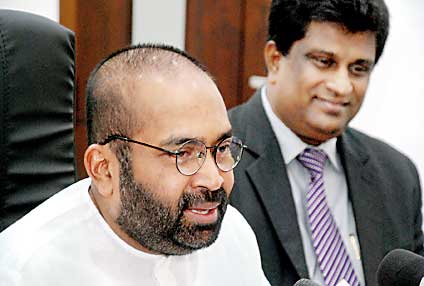Friday Jan 16, 2026
Friday Jan 16, 2026
Thursday, 21 April 2016 00:09 - - {{hitsCtrl.values.hits}}
 By Charumini de Silva
By Charumini de Silva
The Government plans to generate 1,000MW of power via renewable energy sources over the next four years to avert a possible power shortage crisis in 2018, a top official said yesterday.
Under current generation capacity, Sri Lanka faces a possible power supply shortage of 500MW by 2018. To mitigate such a situation, the Government is looking at a mix of renewable energy sources such as LNG, solar, wind and biomass, Power and Renewable Energy Deputy Minister Ajith P. Perera told reporters.
“We cannot set up another coal power plant by 2018; therefore we have identified renewable energy as a key solution for this. This proposal has been approved by the Cabinet of Ministers as well,” he added.
Accordingly, the Government is expecting to generate 600MWs from LNG and 400MWs via solar power.
With the Government’s investment-oriented policies in place to push for rapid economic expansion in industries, FDI projects and rising spending power of the middle class, Sri Lanka’s economy could create a huge demand for electricity, the Deputy Minister noted.
Noting that LNG is a stable power generating source, Perera said they were setting up a plant in Kerawalapitiya with a capacity of 300MW initially, while plans were underway to set up a second plant in the Southern Province.
In addition, three 100MW solar power plants will be set up in the Southern and Eastern Provinces. The Government plans to call tenders for these projects within the next three months. The Ministry intends to set it up with open market funds, while expecting to complete the project by 2018.
Commenting on the proposed 500MW coal power plant in Sampur with Indian assistance, Energy Minister Ranjith Siyambalapitiya said: “The power generation plants I, II and III at Sampur will be operational in near future and if there is no resistance to the project, we can complete the project by 2022. The project is estimated to cost $ 600 million.”
1,000 MW...
According to the action plan, the Sampur coal power plant was supposed to be completed by 2017. Siyambalapitiya pointed out that the majority of criticism was from environmental experts, people from the area and a few politicians.
“The protest is about the emission, not coal. Most of them are complaining about the technology, but we will assure that the best technology will be used for the project and minimise the emissions as much as possible.”
The Sampur coal power plant is a joint venture project between the Ceylon Electricity Board (CEB) and National Thermal Power Corporation Ltd. (NTPC) of India, with the local company being incorporated as the Trincomalee Power Company Ltd.
“A committee including environmentalists and CEB officials has been appointed to search for the best location for the power plant in Trincomalee,” the Minister said.
In terms of financing the project, the Deputy Minister said, “We are going to get money from the open market and we will go for an open tender procedure along with the financing of the project.”
Perera further asserted that the Ministry would launch the ‘100,000 Power Houses’ project within the next month. With this project the Ministry expects to convert the net metering system into net accounting system where households that produce excess solar power will be rewarded when the power is sold to the national grid at a reasonable price.
“We will be deciding on the rate within the next two weeks. At present we generate around 20MW and we want to increase it to 100MW in the near future,” he noted.